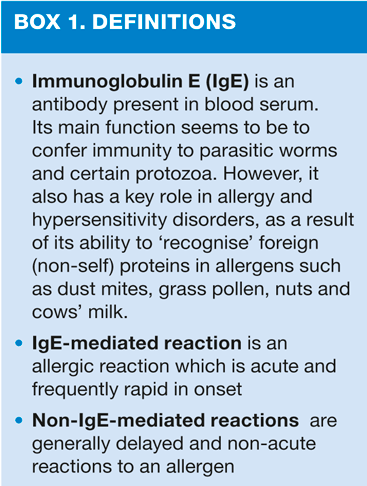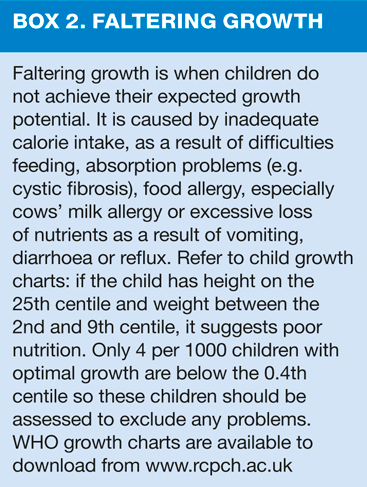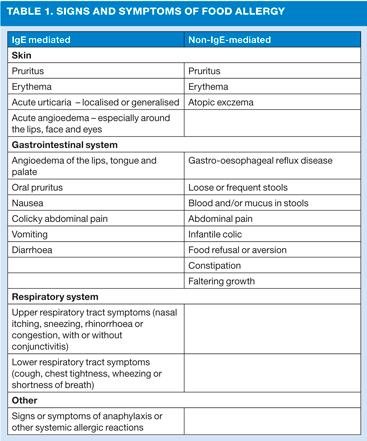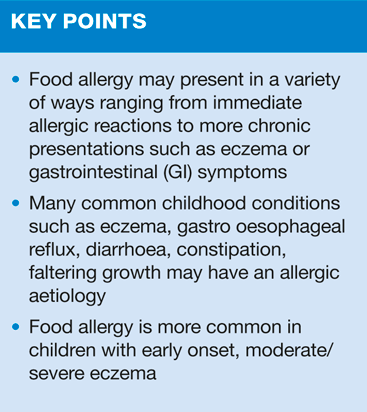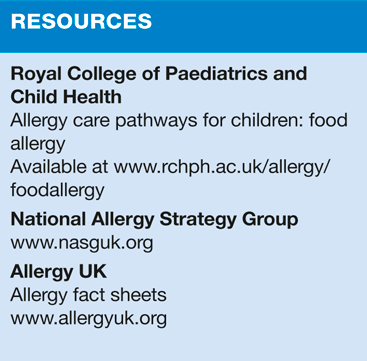Recognising signs of potential food allergy in children
Mandy Galloway
Mandy Galloway
Medical writer
Practice nurses are in an ideal position to spot warning signs of food allergy when providing childhood immunisations or minor illness advice to parents. But what should you look out for?
Food allergy is among the most common of allergic disorders and is recognised as a major child health problem, both because its prevalence is increasing and because of the potential severity of allergic reactions.
Food allergy is thought to affect between 6% and 8% of children under the age of three. Correct diagnosis is essential not only to prevent children suffering allergic reactions, but also to avoid unnecessary exclusion of safe foods from the child's diet.1
A number of surveys have found that 20-30% of people claim to have a food allergy, but the Food Standards Agency estimates that only 5-8% of children and 1-2% of adults have a genuine allergy. The reason for this discrepancy may be because patients mistake intolerance of certain types of food, which does not involve the immune system, for a food allergy that does.2
Allergy can be divided into three main types - IgE-mediated, non-IgE-mediated and mixed IgE- and non-IgE-mediated. (Box 1) Which type of allergy is present may be indicated by the type of symptoms that present.1 (Table 1) NICE recommends that practice nurses should consider the possibility of food allergy in children (and young people) whose symptoms do not respond adequately to treatment for:
- Atopic eczema
- Gastro-oesophageal reflux disease
- Chronic gastrointestinal symptoms, including chronic constipation1
RISK FACTORS
There appears to be a genetic component to the risk of developing a food allergy: one study found a seven-fold increase in the incidence of peanut allergy if the child has a parent or sibling with this allergy.3 Food allergy is also very much more common in children with other atopic disease such as eczema, asthma or allergic rhinitis: 33 - 81% of children with infantile eczema also have IgE-mediated food allergy.3
One of the most common food allergies in very young children is cows' milk allergy (CMA), which is usually non-IgE-mediated. In a study based on data from 300 practices and 1000 babies aged under 1 year with newly diagnosed CMA, the babies were seen in general practice more than 18 times over the course of a year. On average it was 4.2 visits before a food elimination diet was tried, 2.9 months before an appropriate formula was identified and 3.6 months before diagnosis.2 This typical delay in diagnosing the problem and taking appropriate action was one of the reasons that NICE felt it necessary to issue guidance on the diagnosis and assessment of food allergy, including CMA, in children and young people.
CLINICAL HISTORY
You might suspect a food allergy in a baby if the parent says he or she isn't gaining weight, or if the baby has symptoms such as vomiting or loose stools, or persistent diarrhoea. If this is the case - or if the parent suspects an allergy - you need to take an allergy-focused clinical history, adjusted according to the age of the child and his or her symptoms. This needs to include:
- Any personal history of asthma, eczema or allergic rhinitis
- Any history of asthma, eczema or allergic rhinitis or food allergy in parents or siblings
- Details of any foods that are avoided and why
- Presenting symptoms, including
- age when symptoms first started
- speed of onset of symptoms following food contact
- duration of symptoms
- severity of reaction
- frequency
In a young child or a baby, you should ask about the child's feeding history, when they were weaned, whether or not they were breast-fed, and if currently being breast fed, consider the mother's diet.
PHYSICAL EXAMINATION
Examine the child for growth and physical signs of malnutrition or faltering growth. (Box 2)
It is also useful to enquire about any previous treatment, and whether or not it has helped, and whether or not there was any response to the elimination and reintroduction of foods.
Based on the results of the allergy-focused clinical history, if non-IgE-mediated food allergy is suspected, a trial elimination of the suspected allergen should be considered. The foodstuff would usually be avoided for 2-6 weeks, and then reintroduced. However, as always, it is important to practise within your own competencies, and if in doubt, you should seek advice from a dietitian with appropriate competencies, about nutritional adequacies, timings of elimination and reintroduction, and follow-up.
WHEN TO REFER
While it is appropriate to involve a dietitian in the management of young children with suspected food allergy, NICE advises that a referral to secondary care is not warranted for isolated symptoms or conditions, but that acute systemic reactions and/or severe delayed reactions are important indications for referral. In addition, the following should lead to referral to a specialist:
- Positive clinical history for IgE-mediated allergy with negative allergy tests
- Clinical suspicion of multiple food allergies
- Failure to respond to a single-allergen elimination diet.
Other circumstances that warrant referral include:
- Faltering growth in combination with one or more GI symptoms in Table 1
- Confirmed IgE-mediated food allergy and concurrent asthma
- Significant atopic eczema where multiple food allergies are suspected by the parent
- Persisting parent suspicion of food allergy (especially in children with perplexing symptoms) despite absence of supporting history
ROLE OF THE PRACTICE NURSE
The key role of the practice nurse is to provide advice, information and reassurance. Based on the allergy-focused clinical history, offer the child or young person and their parent - or carer - information that is age-appropriate about the type of allergy suspected, the risk of severe allergic reaction, and the potential impact of the suspected allergy on other healthcare issues, including childhood immunisations.
Parents may also welcome information on next steps in reaching a definitive diagnosis, which may include an elimination diet followed by a possible planned re-challenge or initial food reintroduction procedure, skin prick tests and specific IgE antibody testing. With infants, it is important to ensure that parents are aware of the need for alternative sources of adequate nutrition.
With the paucity of training provided to either nurses or GPs on the diagnosis and management of allergies,4 practice nurses cannot be expected to become overnight experts on the topic. Nevertheless, it is important to be aware of signs and symptoms that should raise the index of suspicion for food allergy, so that appropriate action can be taken.
REFERENCES
1. NICE. Food allergy in children and young people: Diagnosis and assessment of food
allergy in children and young people in primary care and community settings. Available at: www.nice.org.uk
2. NHS Choices. Food allergy. Available at: http://www.nhs.uk/conditions/food-allergy/
3. Lack G. Epidemiologic risjs for food allergy. J Allergy Clin Immunol 2008;121:1331-36
4. Lack of training in NHS on allergy. National Allergy Strategy Group www.nasguk.org
Websites accessed February 2012.
Related articles
View all Articles
